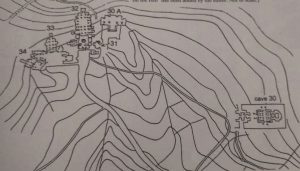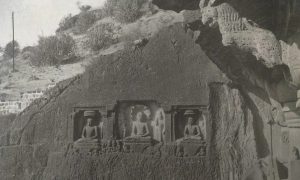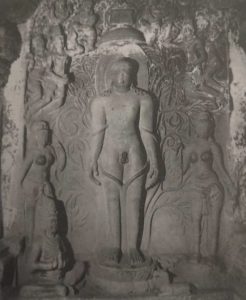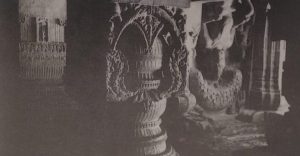Ellora
“Visitors to Ellora see the Jaina temples only after they have looked at Buddhist and Brahmanical ones, that is, when exhausted after their mile-long walk, and with their visual memories loaded with powerful images.
They can then be hardly expected to have any interest left for the Jaina sculptures, and their indifference not seldom tums to revulsion on their being confronted with the wild proliferation of images on the ill-lit cave walls, and which is so oppressive to the wearied sight and brain.”
This being often the case, I would advise my readers to begin their round of the caves with a pleasant early-morning walk to ‘Parshvanatha-on-the-Hill, the further- most of Ellora’s famous sights. And as this shrine is the only one in active worship among the thirty-five Buddhist, Hindu and Jaina cave-temples, the pilgrim has the opportunity of beginning the day with a puja at the feet of this imposing statue before proceeding to the other caves along the bridlepath.
This has the further advantage of not having to walk back in the hot midday hours. (When leaving ‘Parshvanatha-on-the Hill’ one had better not look back, for the concrete structure that has been put up in front of the shallow cave with the Parshvanatha statue is no delight to the eye.)
 * José Pereira: Monolithic Jinas, Delhi 1977: xvii.
* José Pereira: Monolithic Jinas, Delhi 1977: xvii.
Plan of the Ellora Jaina Caves. After José Pereira. (Courtesy Motilal Banarsidass. The location of ‘Parshvanatha on the Hill’ has been added by the editor. Not to scale.)
oposite above). View from the upper story of Cave 32 to- wards ‘Parshvanatha- on-the-Hill’ (ill.131), situated a short way beyond  the bushes in the background.
the bushes in the background.
(opposite below). Cave 32. Bahubali in penance flanked by his two sisters and adored by vidyadharas (divine messengers). Ninth century.
(above). Rock-cut friezes with a seated Parshvanatha. Ellora, Cave 32, known as Indra Sabha. Ninth century.
Interior, Cave 32. “The most elegant temple in all Ellora” (Pereira 1977:26).
 Ellora: “Parshvanatha on the Hill’. The inscription on the pedestal of the above 2.75 metre high statue bears the year 1156 of the Shaka era (AD 1234/35) and reads as follows: “Hail: in the year 1156 of the famous Shaka era, in the year called Jaya. In Shri Vardhanapura was born Rannugi his son (was) Galugi (whose) wife (was) Svarna .
Ellora: “Parshvanatha on the Hill’. The inscription on the pedestal of the above 2.75 metre high statue bears the year 1156 of the Shaka era (AD 1234/35) and reads as follows: “Hail: in the year 1156 of the famous Shaka era, in the year called Jaya. In Shri Vardhanapura was born Rannugi his son (was) Galugi (whose) wife (was) Svarna .
From those two sprang four sons, Chakreshvara and the rest. Chakreshvara was chief among them excelling through the virtue of liberality. He gave, on the hill that is frequented by Charanas, a monument of Parshvanatha, and by (this act of) liberality (he made) an oblation of his karma! Many huge images of the lordly Jinas he made, and converted the Charanadri thereby into the holy tirtha, just as Bharata (made) Mount Kailasha (a tirtha).
among them excelling through the virtue of liberality. He gave, on the hill that is frequented by Charanas, a monument of Parshvanatha, and by (this act of) liberality (he made) an oblation of his karma! Many huge images of the lordly Jinas he made, and converted the Charanadri thereby into the holy tirtha, just as Bharata (made) Mount Kailasha (a tirtha).
The unique image of faith, of firm and pure convictions, kind, constant to his faithful wife, resembling the tree of paradise (in liberality) Chakreshvara becomes a protector of the pure faith . Phalguna 3, Wednesday.” (Pereira, 1977: 93)